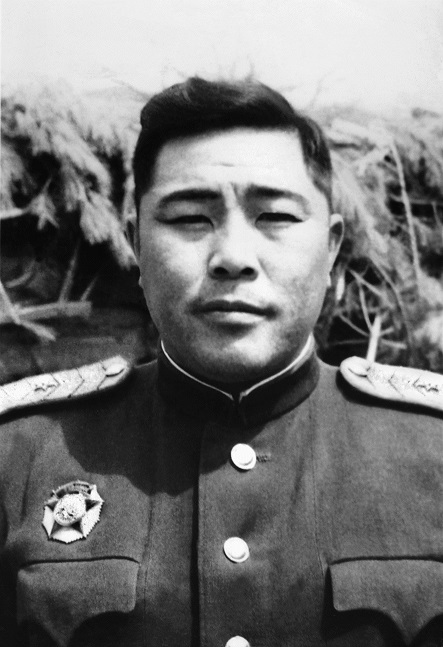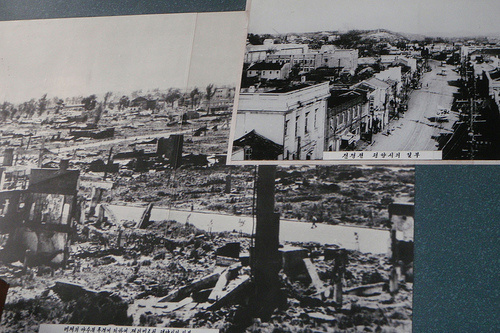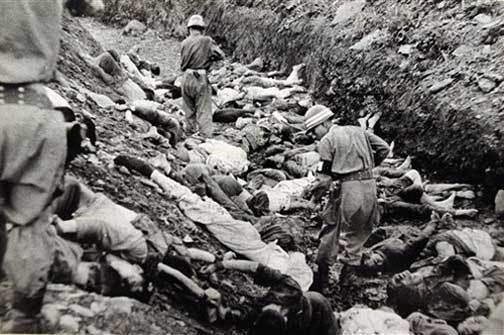
It was not actually the first time that both Koreas have united for the Olympic games. Both have marched together at various events under the same flag, the last time being in Torino 2006. After a long hiatus, they reunited again in 2018. The single blue-and-white flag is meant to signify the symbolic unity of one country artificially divided since 1945.
Ramsay Liem reports for Counterpunch,
In sharp contrast to alarmist views of an erratic and hostile North Korea, the dominant American narrative of South Korea depicts U.S.-South Korea relations as an enduring and equal partnership in the face of a shared enemy. By the grace of U.S. sacrifice during the Korean War, decades of continuing friendship, and a rock-solid U.S.-South Korean mutual defense alliance, the Republic of Korea (ROK) has prospered as a free and independent democracy, or so the narrative goes.Kim Yo-jong, sister of the North Korean leader Kim Jong-un, delivered a letter to the South Korean president, Moon Jae-in, officially inviting him to visit Pyongyang at the "earliest date possible" for what would be the first summit between the two governments in more than a decade.
I. North and South Korean Cooperation as a "Wedge"
What belies this comforting bilateral scenario, however, is the cynical U.S. response to recent joint ROK-DPRK initiatives during the upcoming winter Olympics in Pyeongchang, South Korea. Both sides have agreed that North Korean athletes will participate in the games supported by their own cheer squads. They have further agreed to march under a unification flag at the opening ceremonies, to have their ski teams prepare for competition at an alpine facility in the north, and to field a joint women's hockey team.
Immediately following news that South Korean president Moon Jae-in had accepted North Korean leader Kim Jong-un's proposal for talks on Olympics cooperation, key U.S. officials and prominent news outlets sounded a new specter, the "wedge." Not to be confused with an NFL football tactic, the "wedge" portrays mutual overtures between the North and South as an ominous sign that Kim Jong-un is trying to sow discord between Seoul and Washington in order to weaken the longstanding U.S.-ROK alliance. Recent headlines have sounded the alarm...
More worrisome to U.S. officials and observers, though, is the possibility that North Korea could drive a wedge between Washington and its South Korean ally and historic junior partner by encouraging the latter to undertake independent initiatives to cooperate during the Olympics. This concern reflects a deeper anxiety that the U.S.-ROK Mutual Defense Treaty, the foundation for seven decades of U.S. military presence in South Korea, may itself be vulnerable. The alliance formalized through this treaty has been lauded by every administration since the hot-fighting days of the Korean War as a model of equal partnership bound by shared vigilance against North Korea. The specter of re-triangulation, with North Korea and South Korea taking steps toward peace at a time when the United States is gunning for war, challenges the notion that U.S.-ROK interests are in fact one and the same.
It also calls into question the premise of equal partnership and shared authority as foundational to the U.S.-South Korean alliance. While Secretary of State Rex Tillerson and others moderate their dismay at Moon's initiative by framing North Korea as a threat, Russel's admonition to South Koreans not to "run off the leash" reveals the inequality at the heart of the U.S. relationship with South Korea. It conveys in no uncertain terms the expectation that South Korea, the second most important U.S. ally in Asia, will heel at the command of the United States when called upon. Hardly a metaphor for a mutual alliance, a "dog on a leash" ironically aligns with the familiar North Korean denunciation of its southern neighbor as a client of the United States.

Most people would be surprised how the two Koreas have repeatedly stressed that they have longed for peaceful reunification ever since the Korean War in the 1950s. This is a deeply felt historical desire from North Korea, South Korea, and the Korean diaspora around the world - peace and reunification at last.
My ancestors are from 'North' Korea, but they emigrated to the Far East of Russia when there was no 'North' or 'South' Korea, only Korea. My grandfather, who fought in the Korean War, was thus Russian, though also ethnic Korean. He was made Major-General of the DPRK Army towards the end of the war. His family, including my mother, lived in Pyongyang from 1947 until 1958, except for three years from 1951 when they took shelter in the Russian consulate in Manchuria. When asked whether I'm from North or South Korea, I always clarify that my ancestors emigrated in a time when "North or South" simply did not exist. Korea was in fact a Japanese colony back then.
After the United States nuked Hiroshima and Nagasaki in 1945, they proceeded to divide the Korean peninsula into North and South along the 38th parallel, as if the country was theirs, doing as they damn well pleased with Korea.
As Christine Hong, associate professor at the University of California, clarifies in an interview with Eva Bartlett: "The United States was not responsive to the Korean people's desire for autonomy." She explains how on July 27th 1953, an armistice was signed between China, the United States, North Korea and South Korea. Peace details were to be determined within months of that date. China withdrew its forces from the northern part of the Korean peninsula within 5 years, but the United States to this day keeps approximately 30,000 military troops just south of the 38th parallel and operates approximately 80 military installations in violation of the armistice.
My mother still remembers how, after the armistice was agreed, she was allowed to travel to see my grandfather and, during the trip, their caravan was attacked by American bombers, sending them all running for their lives to the fields and forests for cover.
Since the 1950s and up until today, rounds of economic sanctions against North Korea have been imposed. It was explicitly part of president Truman's war policy and genocidal intentions towards the people of North Korea. The sanctions imposed by the US still prohibit the importation of much-needed hospital equipment into the country. It was and still is an example of collective punishment of the North Korean civilian population. It is a cynical and futile attempt to make life so unbearable for North Koreans that they will be ripe for US-backed 'regime change'. But such measures generally achieve the direct opposite of that goal: a strengthening of nationalist sentiment and hatred for the West.
North Korean leaders are depicted by Western governments and media as grotesque caricatures, as we have seen happen to the leaders of Libya and Syria. These bogus narratives serve as a pretext for interventionist war. The image that is always portrayed is that of a tyrannical leader living a decadent lifestyle while the masses of people suffer. As Christine Hong clarifies, this image of the United States as the hero rushing in to save a beleaguered foreign nation from tyranny is a false one. What actually occurs is that the leadership of the country is removed in a bloody coup that leads to widespread chaos and a humanitarian catastrophe.
Anyone who perceives North Korea as a country in the process of arming itself to its teeth has the right impression. And what unbiased observer could blame them? North Korea officially states that they are in an indefinite defensive mode because of United States military presence at its doorstep. Every time you read about a nuclear test from that 'crazy North Korean leader', remember that the giant elephant in the room was - and still is - the enormous American military presence in South Korea. North Korea openly states that its simultaneous development of the economy and nuclear potential is aimed at the explicit protection of its own people. The 'freedom and democracy' that was bestowed on Libya and Gaddafi serves as an example to every nation in the world that America is not to be trusted.
Christine Hong also expands on infamous North Korean prisoner statistics. According to major corporate news in the 1990s, North Korea had 15,000 political prisoners. Hong, while attempting to verify the source for this number, found that it came from one single defector to South Korea in the early 1990s. There was no external corroboration. And as Hong explains, in the United States, not a single guard in a prison where she taught as a professor was able to tell her the estimated number of prisoners in the United States. A couple of years later, the same defector inflated the number to 900,000 political prisoners. North Korean defectors who become celebrities for major news corporations are routinely paid by the media in Asia to generate new propaganda. The 1990s was a difficult time of intense hardship for North Korean society as a whole. It was the time when the Soviet Union came to an end and a series of floods and droughts exacerbated what was later known as the 'Arduous March' or 'The March of Suffering' in North Korea.
The United States is quick to take the moral high ground when it comes to nuclear weapons, yet the United States was the first and only country to use such weapons against a civilian population. The United States has a very poor track record as a responsible nuclear-armed power. Between 1946 and 1962, the United States conducted a series of nuclear tests in the Marshall islands that were equivalent to 1.6 Hiroshimas per day. The video timeline between "1945-1998" by Isao Hashimoto documents a further 2,053 nuclear explosions conducted in various places around the world, the United States being responsible for over 50% of those detonations:
To understand why North Korea is so antagonistic towards the U.S. today, we need only remember what the U.S. did to North Korea during the Korean war. Bruce Cumings is chairman of the history department at the University of Chicago and author of The Origins of the Korean War, a book in which he details America's saturation bombing of Korea's north. "What hardly any Americans know or remember," Cumings wrote, "is that we carpet-bombed the north for three years with next to no concern for civilian casualties. The United States dropped more bombs in Korea (635,000 tons, as well as 32,557 tons of napalm) than in the entire Pacific theater during World War II. Our logic seemed to be that 'they are savages, so that gives us the right to shower napalm on innocents'."
Years before the US obliterated the Vietnamese peninsula, cities in the Korean peninsula were wiped off the map. Cumings' tally of the degree of destruction of Korean cities include Pyongyang being 75% leveled, Sariwon 95%, and Sinanju 100%. General Douglas MacArthur's US Air Force squadrons bombed dams in the north that unleashed internal tsunamis. Napalm and other weapons were tested on civilians for the first time. "The unhindered machinery of incendiary bombing was visited on the North for three years," he wrote, "yielding a wasteland and a surviving mole people who had learned to love the shelter of caves, mountains, tunnels and redoubts, a subterranean world that became the basis for reconstructing a country and a memento for building a fierce hatred through the ranks of the population. Their truth is not cold, antiquarian, ineffectual knowledge."
Over 4.6 million Koreans died during the war, including 3 million civilians in the north and 500,000 civilians in the south. According to Chinese statistics, North Korea lost 30% of its population. A war like that in the US today would kill 100 million people.
See also Niall Bradley's SOTT Focus How the US Empire was made in North Korea:
Others have written about the intrigues surrounding the installation of US missile systems in South Korea. The upshot of it is that it's happening - with or without a liberal, pro-peace government in Seoul, and regardless of who pays for it. Just as everyone knows that US missile systems in eastern Europe to 'defend Europe from Iran' were actually there to 'contain' Russia, everyone knows that US missile systems in eastern Asia to 'defend it from North Korea' are actually there to 'contain' China.And don't miss Eva Bartlett's interview with Christine Hong, and her travel log to North Korea (Eva Bartlett: The North Korea the Deep State doesn't want the world to see).
It's the same old 70-year-long US 'Policy for Asia'. And, judging by China's meteoric rise, it's still not working, and isn't ever going to work. But North Korea holds fond memories for the US 'wise men' of today, because their New World Order was born amid the charred corpses of millions of North Koreans.







Again we see the pathologically self-referential nature of so much of what passes for US political analysis, particularly concerning international relations.
It would never enter their noggins that North and South Korea are enjoying a brief respite because they want to, and in spite of their ideological differences and historical grievances - not because they want to 'make Trump look bad'.
It's the extreme expression of Eurocentrism - or rather, these days - US-centrism.
It's really ironic that they're 'losing' Korea via a sporting event - that is exactly why they freak out about Russia holding sports events and make its athletes out to be devils; they understand that cultural activities have symbolic potential to affect politics.